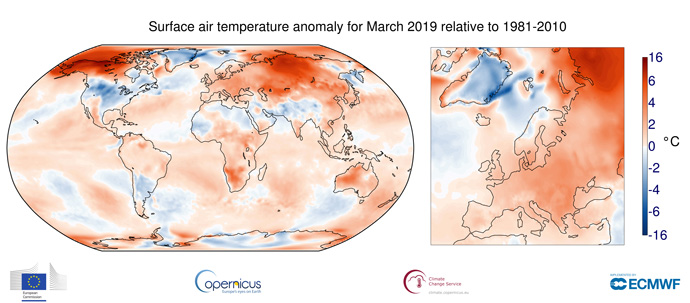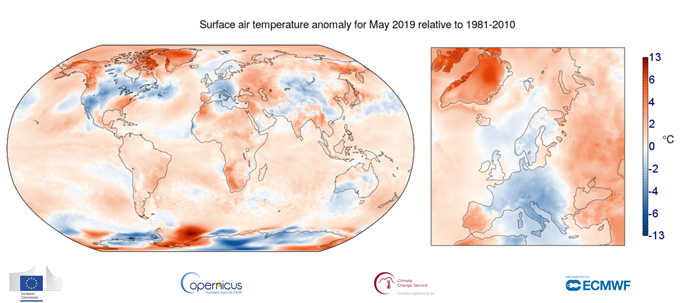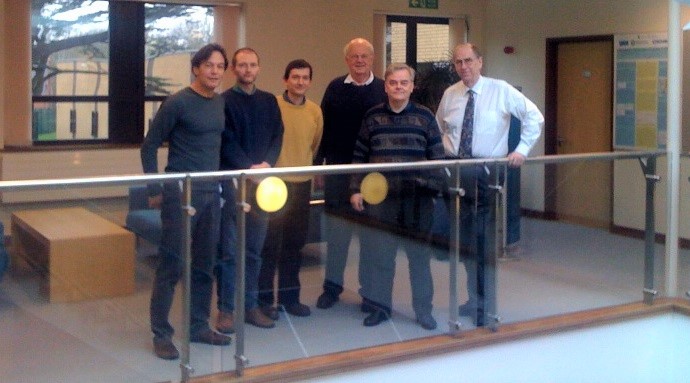

Dick Dee, one of the key figures in the development of global weather and climate reanalysis at ECMWF, is leaving the Centre on 28 June on reaching retirement age, but only after overseeing the transition from the hugely successful ERA-Interim to the state-of-the-art ERA5 reanalysis.
When Dick started to work at ECMWF as a visiting scientist in 2003–04, little did he know that he would return shortly after and stay for the next 15 years, a time he describes as “the best period in my professional life”.
Originally from the Netherlands, Dick spent many years in the US, where in 1983 he completed a PhD in applied mathematics, specialising in the burgeoning field of data assimilation.
Data assimilation is the highly mathematical art of optimally combining short-range forecasts with observations to achieve the best possible estimate of the current state of the Earth system. This estimate, called the analysis, then serves as the starting point for weather forecasts. When it is produced for long periods reaching back decades, but using one and the same forecasting system, it becomes a ‘reanalysis’ of past weather and climate.

In 2018, people in many parts of Europe noticed that the weather was unusually warm in spring and summer – but how much warmer than usual exactly? Reanalysis can help to give the answer, as shown in this chart of near-surface temperature anomalies for the period April–August in central Europe compared to the 1981–2010 average. It shows that the 2018 anomaly was much larger than in any previous year since the middle of the last century. (Credit: ECMWF, Copernicus Climate Change Service)
Working on ERA-Interim
“By the mid-nineties, my work on data assimilation had been noticed at ECMWF, and I was invited to speak at workshops at the Centre,” Dick says.
The former head of ECMWF’s Data Division, Adrian Simmons, remembers that in 2002 Dick chaired a workshop discussion group in which Adrian participated. “Dick’s reputation had preceded him, and he did not disappoint,” Adrian says. “Soon afterwards I mentioned how impressed I was to the then Head of the Research Department, Tony Hollingsworth, who broke into a broad smile and said he had already offered to host a visit from Dick for a year or so.”
As a visiting scientist in 2003–04, Dick worked on variational bias correction, a method to continuously adjust bias corrections for satellite data in an optimal way given all the information used in the analysis.
Coincidentally, it was at this precise time that ECMWF was embarking on a new reanalysis project, led by Sakari Uppala, to support climate studies as well as numerical weather prediction research.
“Saki realised that the ERA-Interim reanalysis that was being planned at the time would greatly benefit from variational bias correction, so he called me into his team,” Dick says. “I’m very grateful for that because it marked the start of the best period in my professional life. For the first time, I felt excited about my work because I could see the value of it for society.”
Saki recalls that case studies demonstrated the benefit of variational bias correction for reanalysis. “Dick’s state-of-the-art technical implementation meant that the ERA-Interim bias correction scheme was able to detect and remove biases that would otherwise have interfered with the climate signal,” he says.

Until March 2019, monthly temperature anomaly maps produced by the EU-funded Copernicus Climate Change Service (C3S) implemented by ECMWF used ERA-Interim data. These charts show surface air temperature anomalies for March 2019 relative to the March average for the period 1981-2010. (Credit: ECMWF, Copernicus Climate Change Service)
Shinya Kobayashi from the Japan Meteorological Agency (JMA), who worked with Dick on ERA-Interim during a secondment at the time, adds that “Dick, with his boundless enthusiasm and energy, rightly considered that reanalysis creates new insights into data assimilation techniques more generally”.
He notes that “for all secondments from JMA to the Reanalysis Section at ECMWF – Kazutoshi Onogi, Hitoshi Sato, Takuya Komori, Shoji Hirahara and myself – working with Dick and seeing his profound knowledge of data assimilation was a memorable experience.”
Dick emphasises that there is “nothing more collaborative” in weather and climate research than reanalysis, a point echoed by his former colleague Paul Poli.
“Working with Dick, you had this feeling that you were contributing to a unique piece of digital knowledge that reached far beyond the individual contributions behind it,” Paul says. “It felt like the pinnacle of all the best science, information technology engineering and administration, and Dick was able to pull it all together.”
Towards a climate change service
When Saki retired in 2008, Dick became the Head of the Reanalysis Section. The challenge at this stage was to put reanalysis activities at ECMWF on a more permanent footing.
“There was still the odd sideswipe at the time from people asking: ‘why are you working with old weather when you should be improving the forecasts instead’,” says Per Kållberg, who worked on reanalysis at ECMWF between 1979 and 2006.
But he adds that the value of reanalysis for advances in data assimilation was becoming increasingly clear. “An independent group could look at the system with fresh eyes and uncover hidden weaknesses,” he says.

Some of Dick’s former colleagues (left to right): Sakari Uppala, Adrian Simmons and Per Kållberg.
The importance of reanalysis for climate monitoring was also starting to sink in, and had been noticed on the continent, at the European Commission in Brussels.
Dick managed to secure funding for the EU-funded, collaborative ERA-CLIM and ERA-CLIM2 reanalysis research projects. These included a major data rescue effort: the unearthing of historical weather observations and preparing them for use in reanalyses.
“These projects were not pure research projects but were intended to pave the way for a climate change service as part of the EU’s Copernicus Earth observation programme,” Dick says.
In 2014, when ECMWF was asked to implement the Copernicus Climate Change Service (C3S) on behalf of the EU, Dick successfully applied for the position of Deputy Head of C3S.
“We had to make the leap from a research activity to an operational service, and five years later we have accomplished that task,” Dick notes.
New reanalyses
Along the way, Dick has supported the development of several ground-breaking reanalyses.
First among these is ERA5, which replaces ERA-Interim for the period from 1979 to the present, and by early next year will extend all the way back to 1950.
“ERA-Interim is an extremely successful reanalysis, which has been widely used for weather and climate research and operationally by C3S to produce regular climate updates,” Dick notes. “But the forecasting system used to produce it is now 13 years old, and it is no longer able to take full advantage of the modern observing system.”
ERA-Interim will therefore be retired this summer, with no new data being produced beyond August 2019. “ERA5 offers many benefits compared to ERA-Interim and is fully supported operationally by C3S,” Dick says.

Today ERA5 is used routinely by C3S to help produce monthly climate bulletins. These charts show surface air temperature anomalies for May 2019 relative to the May average for the period 1981-2010, according to ERA5 data. (Credit: ECMWF, Copernicus Climate Change Service)
Meanwhile, other reanalyses produced as part of the ERA-CLIM projects are proving invaluable for progress in data assimilation as implemented in ECMWF’s Integrated Forecasting System (IFS).
These include two reanalyses covering the entire 20th century, ERA-20C and the coupled reanalysis CERA-20C, as well as the coupled satellite-era reanalysis CERA-SAT.
“These projects have made it possible to explore data assimilation techniques which better reflect interactions between different components of the Earth system, proving the point that reanalysis is extremely useful to numerical weather prediction,” Dick says.
Paul Berrisford, who has known Dick since he came to ECMWF to work on reanalysis 12 years ago, emphasises Dick’s “substantial contributions to the vision for ERA-Interim, ERA5, and the 20th century reanalyses, as well as many C3S services, such as the C3S Data Rescue Service”.
“As head of the reanalysis group, he always provided a clear view on the way forward for new projects and for solving problems in existing ones.”

Dick with his colleagues and former colleagues in the reanalysis team at ECMWF in December 2009 (left to right): Dick Dee, Paul Berrisford, Paul Poli, Per Kållberg, Sakari Uppala and Adrian Simmons. “It is a privilege to have been able to work with all these wonderful people,” says Dick.
What next?
After his long stint in Europe, Dick is set to return to the US. “An exciting challenge is waiting for me at the Joint Center for Satellite Data Assimilation (JCSDA), where I will start a new job in October,” he says.
Head of C3S Jean-Noël Thépaut is pleased that Dick is not yet calling it a day. “It’s great to see that Dick has found a new opportunity to put his wide-ranging expertise to good use. We wish him all the best in his new venture, and I am confident that one way or another Dick will continue to inspire us all to make C3S ever better!”
